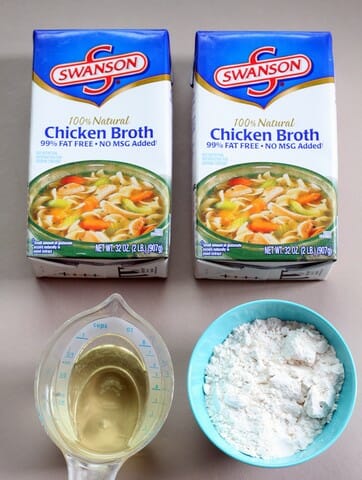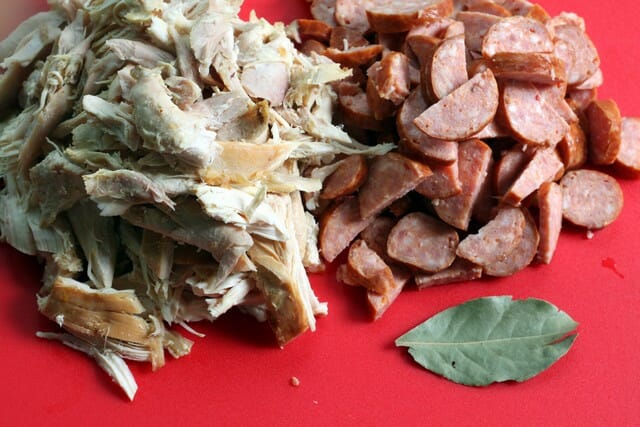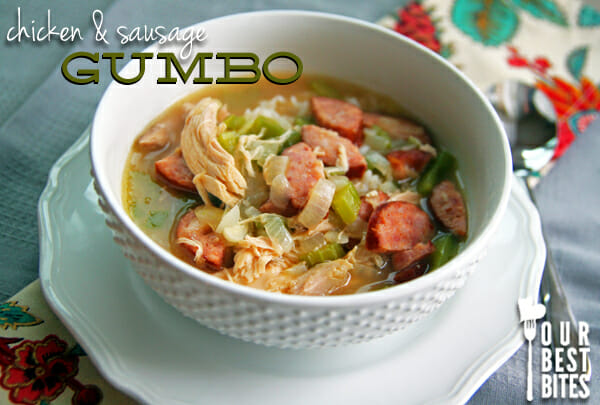When we moved to Louisiana, I decided that I was going to embrace the experience, especially when it came to the food. I set out to try everything I could and to not be scared, even if it was something I’d never eaten before.
What I discovered was this: Louisiana is famous for their food for a reason. It can be amazing. That said, just because a kitchen is located in Louisiana doesn’t mean the food that comes out of it is going to be automatically fabulous. There are some recipes and methods that people might consider retiring (like all the times I’ve experienced un-de-veined shrimp…seriously, guys, it’s poop.)
I had some bad run-ins with gumbo. The first was a fishy (and not in a good way) shrimp gumbo. And then there was a super-bland gumbo that kind of tasted like lifeless chicken soup. And then there was the epic nightmare of gumbo with okra. Funny thing–turns out I don’t like okra. It makes food taste like morning sickness–like I knew in my brain that it tasted good, but my gag reflex was in overdrive. And then I had some at a fancy-ish restaurant in New Orleans and it was just flat-out gross. And then I had gumbo that I was pretty sure could have been good, but the roux had burned and once the roux burns, it’s all over.
So I kind of gave up on gumbo. I felt like I’d given it a fair shake. I could see how it could be good, but it just seemed like too many things could go wrong. It was like the J-Lo of Cajun cuisine and I wasn’t willing to put up with her high-maintenance antics.
And then in December, I met up with my son for lunch at his plantation field trip and one of the teachers made gumbo. And it was incredible. After an unbelievably stressful fall, heck, a stressful year, and then a house full of sick kids at home, including a baby with RSV, and Christmas on its way, I felt like it fed my soul. It was seriously comfort food at its finest.
One thing I loved about it is that her recipe was simple. I didn’t get her recipe, but from what I could tell, it wasn’t more than a dark roux, celery, bell pepper, onions, garlic, chicken broth, tender chunks of chicken, and smoked sausage. A lot of recipes call for fresh herbs, additional spices, other vegetables, and then there are the meats-gumbo can be loaded up with all sorts of meat, ranging from wild game to seafood. And the best part? It was okra-free.
So I went on a quest to try all sorts of gumbo in hopes of making my own that I liked just as much as the gumbo I had on the field trip. Turns out I do not hate gumbo. In fact, I kind of love it.
The ingredients are simple–so simple, in fact, that it’s kind of magical that it ends up tasting the way it does. The base of the flavor comes from a vegetable oil with a high smoke point (like peanut or canola), flour, and chicken broth.
Really, you should probably use a low-sodium chicken broth because so many of the other ingredients are salty that you want to be able to control the saltiness.
You’re also going to need vegetables–the “holy trinity” (chopped celery, onion, and green bell pepper) and a whole bunch of garlic.
And finally, you’re going to need meat. Lots of meat. For the chicken, I just picked the white and dark meat off of a rotisserie chicken. As far as sausage goes, if you’re living in the South, it’s easy to find really good smoked sausage at pretty much any grocery store. If you can’t find a good smoked or andouille sausage at your local grocery store, try Costco or Sam’s Club–they often have really high-quality options. Another good choice is to check with your butcher; many butchers make their own smoked sausages and they can be incredible.
Now…the scariest part of this whole experience is making the roux. This roux is totally different than any other kind of roux I’ve ever made–usually, roux is used to thicken soups and sauces and custards. Here, it is solely used for flavor; this particular gumbo is not thick at all. And it’s not made with a tasty oil like butter or olive oil, it’s made with plain ol’ vegetable oil. And yet the roux is what makes the gumbo so delicious–it gives the gumbo the rich, smoky flavor. If you make it right, you’ll have a hit on your hands. If it burns or if you don’t get it dark enough, it will be ruined.
I tried, I really did, to get pictures of this whole process, but I don’t have any natural light in my kitchen. The chances of me screwing everything up by moving back and forth between my kitchen and the window were so great that I didn’t want to risk it, so we’re going to play the imagination game here.
In a large, heavy pot (like a Dutch oven), heat the oil over medium heat until very hot (about 3-4 minutes). Add the flour and whisk until smooth, then use a wooden spoon or spatula to stir the mixture until it becomes the color of caramel (about 15-20 minutes). You may need to reduce to heat to medium low if you start feeling like you can’t stir fast enough to keep it from sticking on the bottom or burning. If it burns (and you start seeing black flecks–not 1 or 2 black flecks, but several), you’ll need to toss it and start over. If you don’t start over, you will be sad 3 hours from now when your gumbo is horrible.
When the roux is brown (approximately the color of melted caramel or turkey gravy, or darker–you can go as dark as chocolate if you like it and you know you can pull it off), add the onions, celery, and bell pepper. Cook for 4-6 minutes or until fragrant and the vegetables are tender. Add the minced garlic and cook for another 2-3 minutes. Add the chicken broth and bay leaf and whisk until the roux and broth are combined. Bring to a boil, then add the sausage and chicken. Cover and reduce to a simmer. Cook for 1 hour. Skim the oil off the top, then simmer for another hour. Skim for oil again. Season to taste with Cajun seasoning (look for Tony Chachere’s and skip the tiny expensive jars) and Tabasco sauce (the Cajun seasoning is salty and spicy, and the Tabasco is just spicy, so if you have enough salt, but need a little more heat, add some Tabasco).
To serve, place about 1/2 cup of hot white rice in the bottom of a bowl. Ladle the gumbo on top of the rice, making sure to get sausage, chicken, and broth in each bowl. Serves 10-12 (or 8-10 very large servings).
Now…the very best things you can possibly make your gumbo in is a large cast-iron Dutch oven or in an enamel-coated cast iron pan (often called a French oven) like a Le Creuset pot. They retain heat well and distribute it evenly, so you’re less likely to run into burning.
It’s February. If you live in the Northern Hemisphere, pretty much no matter where you live, it is dreary and dark and blah-ish. Perfect gumbo weather. “But alas,” you say, “I don’t have anything to cook my gumbo in.”
That’s why you need one of these:
Click on the picture for details on how to enter–comments on this post are for the gumbo only and any giveaway entries on this post will be deleted.
So happy Mardi Gras to you! For other Mardi Gras-friendly recipes, click here. And since Valentine’s Day is also this week, click here for all sorts of awesome Valentine’s Day ideas. Apparently it’s also the Chinese New Year (maybe THIS year will finally be the end of the world since all this magic is happening at once). We don’t have tons of Chinese-specific recipes, but if you’re looking for a little Asian flair, here are some ideas!
Chicken & Sausage Gumbo
Recipe by Our Best Bites, adapted from several cookbooks and online sources
Ingredients:
2/3 cup vegetable oil (like peanut oil)
2/3 cup all-purpose flour
1 large onion, chopped
2 stalks celery, chopped
1 large green bell pepper, seeded and chopped
6 cloves garlic, minced
8 cups low-sodium chicken broth (this lets you adjust the salt as necessary–the sausage, chicken, and seasonings are all salty, so you don’t want your gumbo to be too salty.)
1 bay leaf
1 pound smoked sausage, halved and cut into slices
Meat from 1 rotisserie chicken, shredded into large-ish chunks
Cajun seasoning and Tabasco sauce to taste
Instructions:
In a large, heavy pot (like a Dutch oven), heat the oil over medium heat until very hot (about 3-4 minutes). Add the flour and whisk until smooth, then use a wooden spoon or spatula to stir the mixture until it becomes the color of caramel (about 15-20 minutes). You may need to reduce to heat to medium low if you start feeling like you can’t stir fast enough to keep it from sticking on the bottom or burning. If it burns (and you start seeing black flecks–not 1 or 2 black flecks, but several), you’ll need to toss it and start over.
When the roux is brown (approximately the color of caramel or turkey gravy, or darker if you like it and you know you can pull it off), add the onions, celery, and bell pepper. Cook for 4-6 minutes or until fragrant and the vegetables are tender. Add the minced garlic and cook for another 2-3 minutes. Add the chicken broth and bay leaf and whisk until the roux and broth are combined. Bring to a boil, then add the sausage and chicken. Cover and reduce to a simmer. Cook for 1 hour. Skim the fat, then simmer for another hour. Skim for oil again. Season to taste with Cajun seasoning and Tabasco sauce (the Cajun seasoning is salty and spicy, and the Tabasco is just spicy, so if you have enough salt, but need a little more heat, add some Tabasco).
To serve, place about 1/2 cup of hot white rice in the bottom of a bowl. Ladle the gumbo on top of the rice, making sure to get sausage, chicken, and broth in each bowl. Serves 10-12 (or 8-10 very large servings).












Questions & Reviews
I usually lightly season and fry chicken thighs in the oil until almost done. Take the chicken out and use the oil it fried in to make the roux, adding more oil if needed. At the end we add some file powder to thicken it a bit.